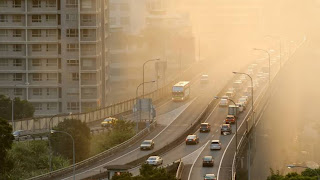Air Pollution
Air is mainly a mixture of various gases such as oxygen, carbon dioxide, nitrogen. These are present in a particular ratio. Whenever there is any imbalance in the ratio of these gases, air pollution is caused. The sources of air pollution can be grouped as under
(i) Natural : such as, forest fires, ash from smoking volcanoes, dust storm and decay of organic matters.
(ii) Man-made : due to population explosion, deforestation, urbanization and industrialization.
Certain activities of human beings release several pollutants in air, such as carbon monoxide (CO), sulfur dioxide (SO2), hydrocarbons (HC), oxides of nitrogen (NOx), lead, arsenic, asbestos, radioactive matter, and dust. The major threat comes from burning of fossil fuels, such as coal and petroleum products. Thermal power plants, automobiles and industries are major sources of air pollution as well. Due to progress in atomic energy sector, there has been an increase in radioactivity in the atmosphere. Mining activity adds to air pollution in the form of particulate matter. Progress in agriculture due to use of fertilizers and pesticides has also contributed towards air pollution. Indiscriminate cutting of trees and clearing of forests has led to increase in the amount of carbon dioxide in atmosphere.
Global warming is a consequence of green house effect caused by increased level of carbon dioxide (CO2). Ozone (O3) depletion has resulted in UV radiation striking our earth.
The gaseous composition of unpolluted air :
|
The Gases |
Parts per million (vol) |
|
Nitrogen |
756,500 |
|
Oxygen |
202,900 |
|
Water |
31,200 |
|
Argon |
9,000 |
|
Carbon Dioxide |
305 |
|
Neon |
17.4 |
|
Helium |
5.0 |
|
Methane |
0.97-1.16 |
|
Krypton |
0.97 |
|
Nitrous oxide |
0.49 |
|
Hydrogen |
0.49 |
|
Xenon |
0.08 |
|
Organic vapours |
ca.0.02 |
Global warming is a consequence of green house effect caused by increased level of carbon dioxide (CO2). Ozone (O3) depletion has resulted in UV radiation striking our earth.
Industrial / Vehicular pollution :
The coolest culprits of environmental degradation in metropolitan cities are vehicular and industrial pollution. Since 1975 the Indian economy has grown 2.5 times, the industrial pollution load has grown 3.47 times and the vehicular pollution load 7.5 times, in Delhi, for example 70% of air pollution is caused by vehicular pollution. Thanks to the 3 million vehicles on its roads-while industries account for 17%. The pollutants emitted by the vehicles could produce inflammatory effects on the respiratory organs, could be toxic or even carcinogenic depending upon the fuel type, In India, vehicles primarily run on diesel or petrol.
Harmful Effects of air pollution :
(a) It affects respiratory system of living organisms and causes bronchitis, asthma, lung cancer, pneumonia etc. Carbon monoxide (CO) emitted from motor vehicles and cigarette smoke affects the central nervous system.
(b) Due to depletion of ozone layer, UV radiation reaches the earth. UV radiation causes skin cancer, damage to eyes and immune system.
(c) Acid rain is also a result of air pollution. This is caused by presence of oxides of nitrogen and sulfur in the air. These oxides dissolve in rain water to form nitric acid and sulfuric acid respectively. Various monuments, buildings, and statues are damaged due to corrosion by acid present in the rain. The soil also becomes acidic. The cumulative effect is the gradual degradation of soil and a decline in forest and agricultural productivity.
(d) The green house gases, such as carbon dioxide (CO2) and methane (CH4) trap the heat radiated from earth. This leads to an increase in earth’s temperature.
(e) Some toxic metals and pesticides also cause air pollution.
Written by : Jayanta Kumar Meher (BSc, BEd)












0 Comments